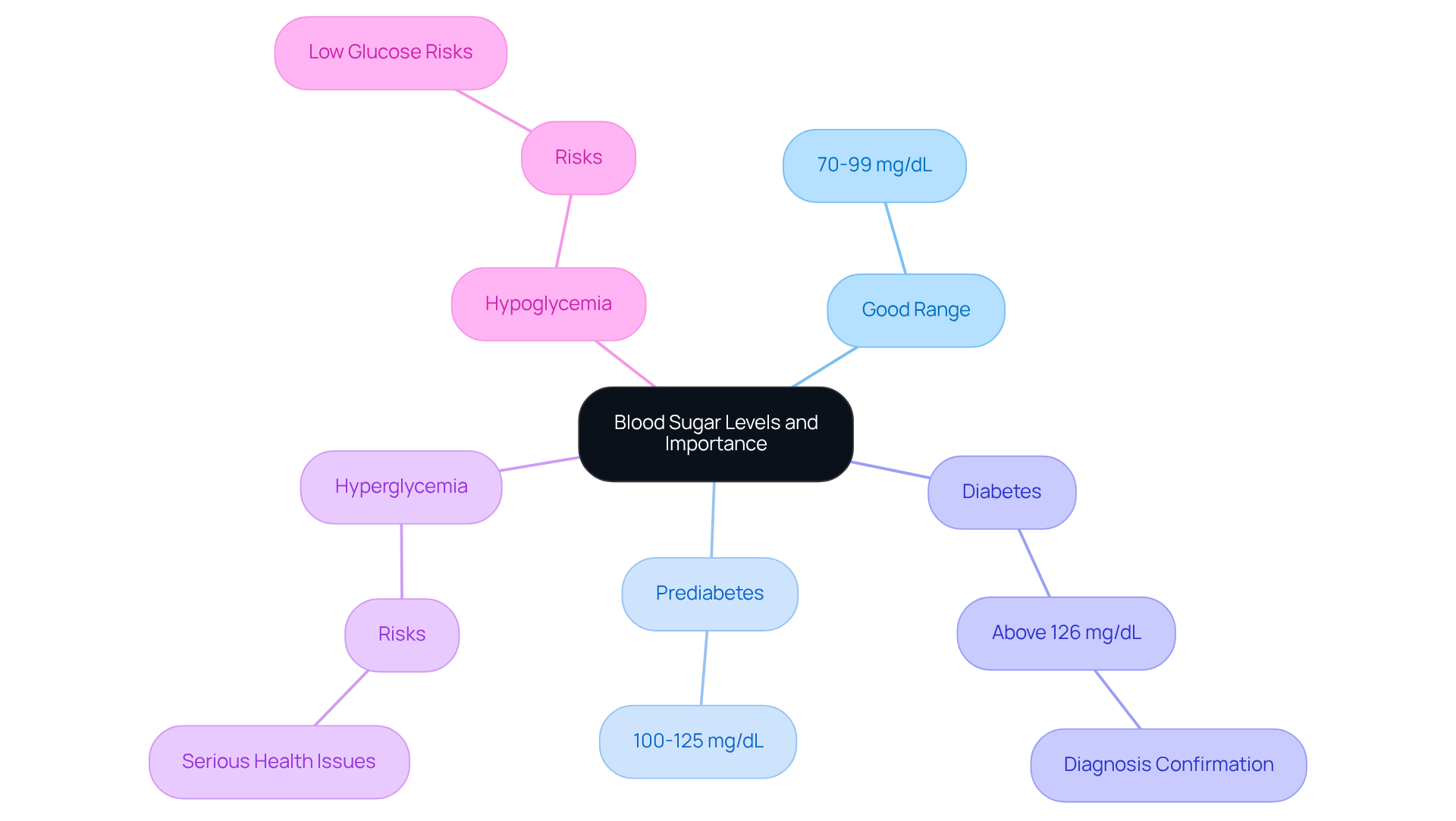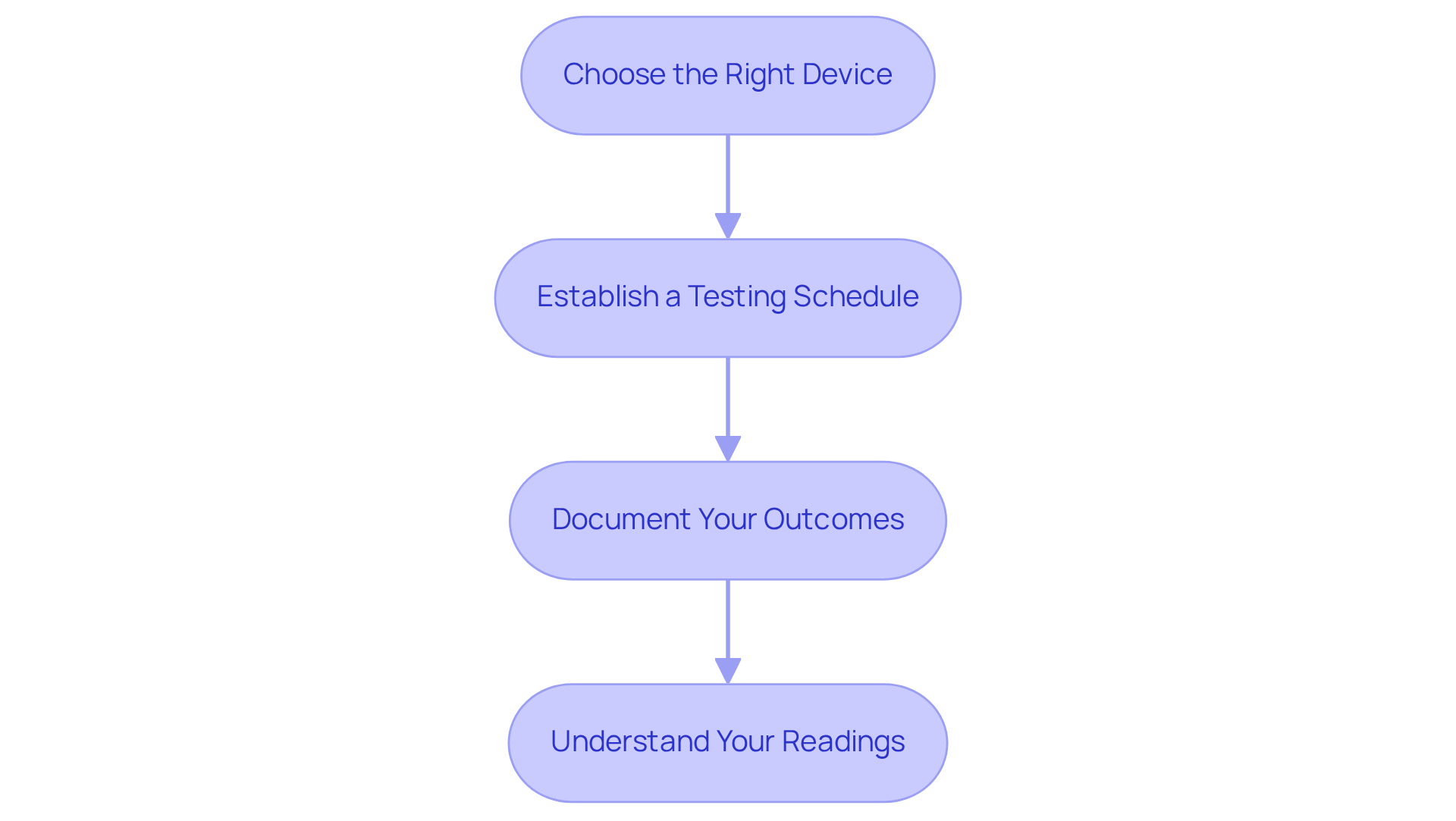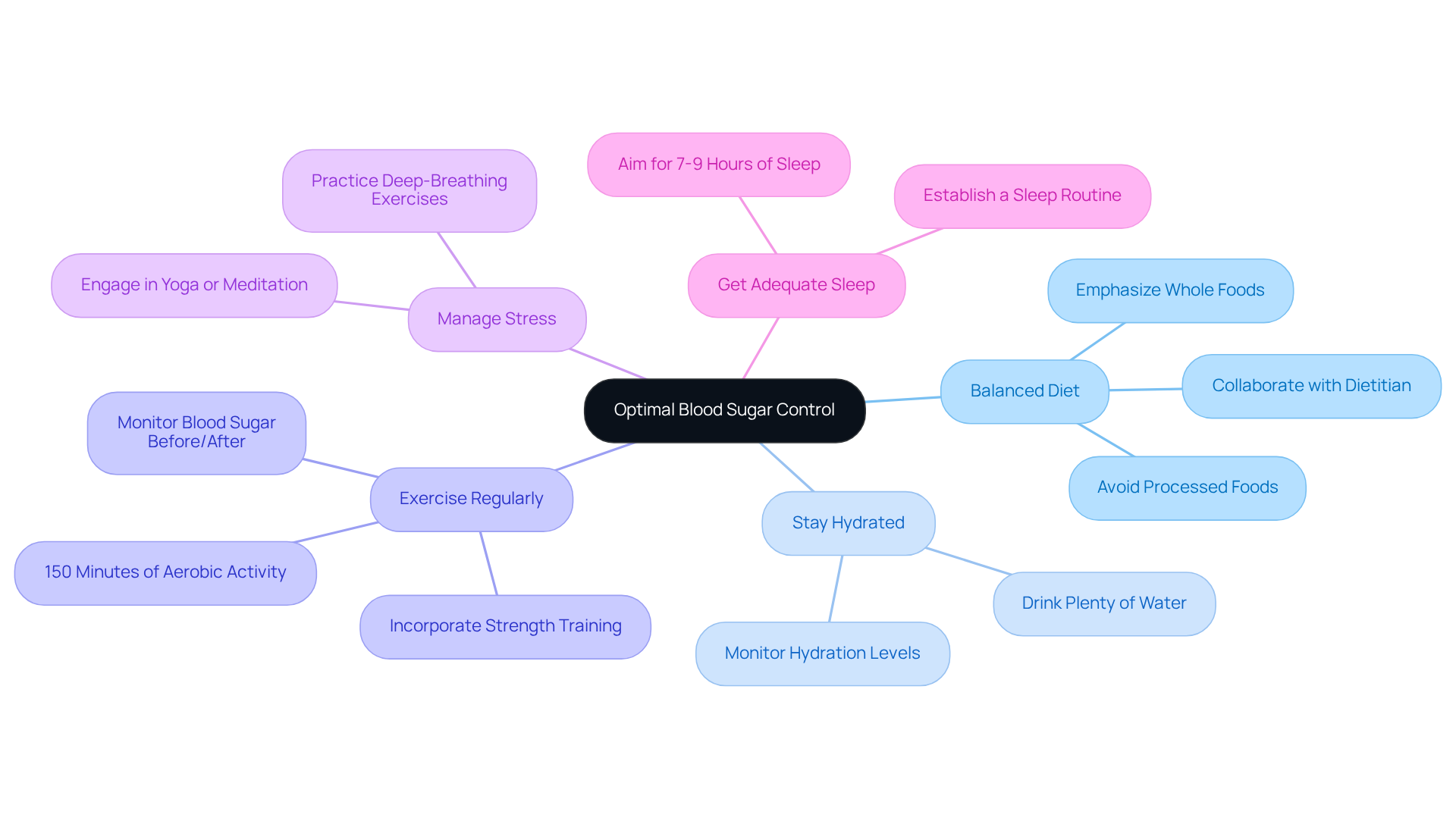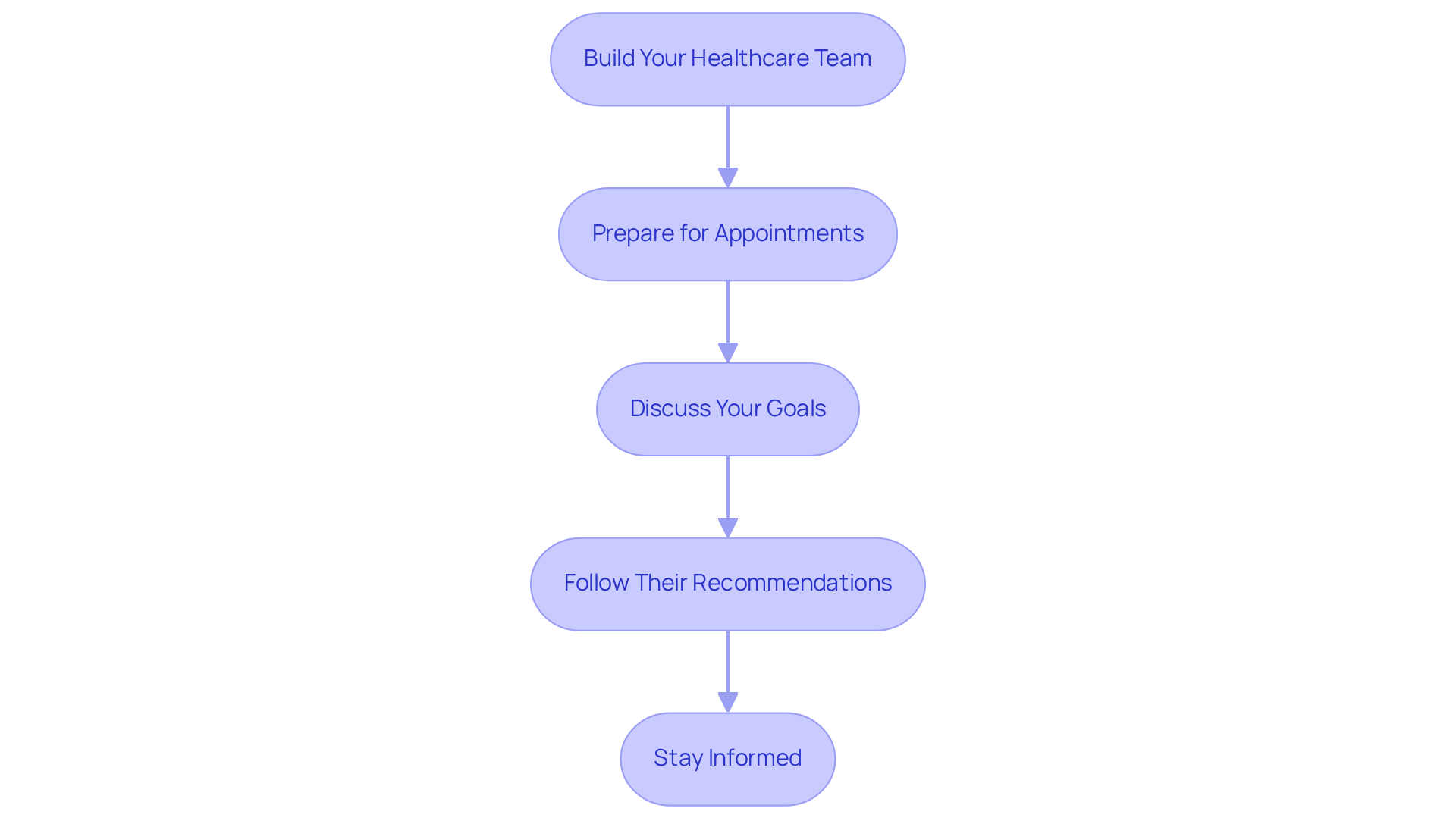Overview
Managing your blood sugar levels is crucial for those with Type 2 Diabetes, and you’re not alone in this journey. Regularly monitoring your glucose levels can empower you to take control of your health. Alongside this, implementing lifestyle changes—like adopting a balanced diet and incorporating exercise—can make a significant difference.
It’s understandable to feel overwhelmed, but remember that you have the support of healthcare providers who can offer personalized guidance tailored to your needs. Consistent monitoring, combined with informed dietary choices and physical activity, is essential for maintaining optimal glucose control. This proactive approach not only helps in managing your diabetes but also plays a vital role in preventing complications.
You are taking important steps toward a healthier life, and we are here to support you every step of the way. Consider reaching out to your healthcare team for resources and support tailored to your unique situation. Together, we can navigate this path to better health.
Introduction
Understanding blood sugar levels is crucial for anyone managing Type 2 Diabetes. These levels not only influence daily well-being but also impact long-term health outcomes. In this article, we explore essential strategies for maintaining a healthy blood sugar range, offering you actionable steps to enhance your glucose management.
It's understandable to feel overwhelmed by the conflicting information available. So, how can you ensure that you are following the most effective practices tailored to your unique needs? You're not alone in this journey, and we are here to support you every step of the way.
Understand Blood Sugar Levels and Their Importance
Blood glucose concentrations, measured in milligrams per deciliter (mg/dL), reveal the amount of glucose in your bloodstream and are crucial for those living with Type 2 Diabetes. It's important to maintain these levels within the good blood sugar range for type 2 diabetes to prevent complications. A standard fasting glucose reading typically falls between 70 and 99 mg/dL. If your levels range from 100 to 125 mg/dL, this indicates prediabetes, while readings above 126 mg/dL on two separate occasions confirm a diabetes diagnosis.
Recent studies highlight the prevalence of hyperglycemia and hypoglycemia among individuals with Type 2 Diabetes, emphasizing the importance of regular monitoring. Hyperglycemia, characterized by elevated glucose levels, can lead to serious health issues, while hypoglycemia, or low glucose, poses its own risks. Understanding these ranges empowers you to recognize when your glucose levels are too high or too low, enabling timely interventions.
For instance, patients like Yasin, who experienced significant weight loss after surgery, have shared how dietary changes and consistent monitoring have improved their glucose management. Similarly, Jennifer's journey illustrates the importance of lifestyle modifications in maintaining optimal glucose levels.
Experts recommend that individuals frequently check their glucose levels to ensure they stay within the good blood sugar range for type 2 diabetes. This proactive approach allows for informed choices regarding diet, exercise, and medication, ultimately leading to better health outcomes. To further assist you in managing Type 2 Diabetes, T2DSolutions provides a wealth of resources and community support specifically designed for newly diagnosed patients. Explore T2DSolutions to discover valuable information and tools that can help you achieve and maintain healthy glucose levels.

Monitor Your Blood Sugar Regularly
Regular glucose monitoring is essential for achieving and maintaining a good blood sugar range for type 2 diabetes. By using either a glucose meter or a Continuous Glucose Monitor (CGM), you can significantly enhance your ability to maintain a good blood sugar range for type 2 diabetes. Here’s how to approach this important task:
-
Choose the Right Device: It’s vital to select a glucose meter that suits your specific needs. Look for one that is user-friendly and provides accurate readings. Continuous Glucose Monitors (CGMs) are also highly effective, offering real-time information and alerts for elevated or reduced glucose levels. This can help you prevent complications and feel more in control of your health.
-
Establish a Testing Schedule: Regular testing is crucial for your well-being. Aim to check your blood sugar at key times, including:
- Before meals
- 1-2 hours after meals
- Before bedtime
- Whenever you experience symptoms of high or low blood sugar
This routine helps you understand how your body responds to food, activity, and medication, empowering you to make informed choices.
-
Document Your Outcomes: Keeping a record of your glucose levels is essential for recognizing trends. This information can be invaluable for you and your healthcare provider in making informed decisions about your management plan. Regularly reviewing your data can highlight trends that may require adjustments in your treatment. Remember, you’re not alone in this journey; support is available.
-
Understand Your Readings: Familiarize yourself with what your glucose levels indicate. For instance, a good blood sugar range for type 2 diabetes suggests that fasting glucose levels should ideally be between 80-130 mg/dL, while post-meal levels should be under 180 mg/dL. Consistently high readings may signal the need for dietary changes or medication adjustments. It’s understandable to feel overwhelmed, but knowledge is a powerful tool.
By committing to regular monitoring, you empower yourself to take proactive steps in managing your diabetes effectively, ultimately leading to better health outcomes. We are here to support you every step of the way.

Implement Lifestyle Changes for Optimal Blood Sugar Control
Implementing lifestyle modifications can greatly improve glucose management and help you maintain a good blood sugar range for type 2 diabetes, and you're not alone in this journey. Here are some effective strategies to consider:
-
Adopt a Balanced Diet: Emphasize whole foods, including a variety of vegetables and fruits, whole grains, lean proteins, and healthy fats like avocados and nuts. It's important to avoid processed foods, sugary snacks, and beverages that can lead to spikes in blood sugar levels. Nutritionists suggest focusing on nutrient-rich choices to enhance overall health and glucose control. Collaborating with a dietitian or diabetes educator can help you create a personalized healthy eating plan tailored to your needs.
-
Stay Hydrated: Remember to drink plenty of water throughout the day. Adequate hydration helps your kidneys expel surplus glucose through urine, which is essential for maintaining a good blood sugar range for type 2 diabetes.
-
Exercise Regularly: Aim for at least 150 minutes of moderate aerobic activity each week, such as brisk walking or cycling. Incorporating strength training exercises at least twice a week can enhance insulin sensitivity and glucose uptake by your muscles. Regular physical activity has been shown to significantly improve glycemic control, which is essential for achieving a good blood sugar range for type 2 diabetes and enhancing overall well-being.
-
Manage Stress: It's understandable to feel overwhelmed at times. Elevated stress levels can negatively influence glucose concentrations. Engage in stress-reducing techniques such as yoga, meditation, or deep-breathing exercises to promote mental well-being and improve your health management.
-
Get Adequate Sleep: Strive for 7-9 hours of quality sleep each night. Inadequate rest can adversely affect glucose levels and insulin sensitivity, making it crucial for effective management of your condition.
Implementing these lifestyle changes can lead to improved blood sugar control and help achieve a good blood sugar range for type 2 diabetes, enhancing overall health. Remember, we are here to support you every step of the way.

Consult Healthcare Providers for Personalized Guidance
Effective management of blood sugar issues relies on teamwork with healthcare providers. Here’s how you can optimize your consultations:
-
Build Your Healthcare Team: Assembling a team that includes a primary care physician, a certified educator for blood sugar management, a registered dietitian, and potentially an endocrinologist is essential. Each member brings unique expertise to your care, addressing various aspects of diabetes management. Team-based care (TBC) interventions have been shown to improve diabetes-related outcomes, with reductions in HbA1c levels by an average of 0.5%.
-
Prepare for Appointments: Before your visit, it’s helpful to jot down any questions or concerns you may have. Bringing along your blood sugar log and relevant health information can facilitate a productive discussion, making you feel more empowered.
-
Discuss Your Goals: Clearly communicating your personal health objectives with your healthcare team is vital. This dialogue allows them to customize their recommendations to better align with your lifestyle and preferences. Remember, it’s understandable to feel a bit overwhelmed; you’re not alone in this journey.
-
Follow Their Recommendations: Committing to the treatment plan and lifestyle changes proposed by your healthcare providers is crucial. Regular follow-ups are important for monitoring your progress and making necessary adjustments. It’s worth noting that only 52% of adults with this condition reported receiving education related to it, highlighting the importance of seeking support.
-
Stay Informed: Continuously educating yourself on the latest blood sugar management strategies and research empowers you to engage in meaningful conversations with your healthcare team. As highlighted, "This study demonstrates that receiving education on managing blood sugar is a crucial aspect of care."
By actively collaborating with healthcare providers and utilizing resources from T2DSolutions, you can develop a personalized diabetes management plan that effectively meets your unique needs. Remember, we are here to support you every step of the way.

Conclusion
Maintaining a good blood sugar range is vital for individuals with Type 2 Diabetes. It helps prevent complications and promotes overall health. In this article, we've outlined essential steps to achieve optimal glucose control, highlighting the importance of regular monitoring, lifestyle changes, and collaboration with healthcare providers. By understanding blood sugar levels and their implications, you can make informed decisions that significantly impact your well-being.
Key insights discussed include:
- The necessity of frequent glucose testing
- Adopting a balanced diet
- Engaging in regular physical activity
- Managing stress
Each of these elements plays a crucial role in keeping blood sugar levels within the recommended range. Remember, building a supportive healthcare team is equally important, as personalized guidance and education can enhance the effectiveness of your diabetes management plan.
Ultimately, the journey to effective blood sugar control is a collaborative effort that requires your commitment and proactive measures. Embracing these strategies not only fosters better health outcomes but also empowers you to take charge of your diabetes management. By prioritizing blood sugar control, you can lead a healthier, more fulfilling life while minimizing the risks associated with Type 2 Diabetes. You're not alone in this journey; we are here to support you every step of the way.
Frequently Asked Questions
What are blood sugar levels and why are they important for individuals with Type 2 Diabetes?
Blood sugar levels, measured in milligrams per deciliter (mg/dL), indicate the amount of glucose in the bloodstream. They are crucial for individuals with Type 2 Diabetes to maintain within a good range to prevent complications.
What is the standard range for fasting glucose readings?
A standard fasting glucose reading typically falls between 70 and 99 mg/dL.
What do glucose readings indicate in terms of diabetes diagnosis?
Readings from 100 to 125 mg/dL indicate prediabetes, while readings above 126 mg/dL on two separate occasions confirm a diabetes diagnosis.
What are hyperglycemia and hypoglycemia?
Hyperglycemia is characterized by elevated glucose levels, which can lead to serious health issues. Hypoglycemia refers to low glucose levels, which also poses risks to health.
Why is it important to monitor blood sugar levels regularly?
Regular monitoring of blood sugar levels helps individuals recognize when their glucose levels are too high or too low, enabling timely interventions and informed choices regarding diet, exercise, and medication.
Can lifestyle changes impact glucose management in Type 2 Diabetes?
Yes, lifestyle modifications, such as dietary changes and consistent monitoring, can significantly improve glucose management for individuals with Type 2 Diabetes.
What resources are available for individuals newly diagnosed with Type 2 Diabetes?
T2DSolutions provides a wealth of resources and community support specifically designed for newly diagnosed patients to help them achieve and maintain healthy glucose levels.



